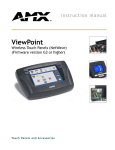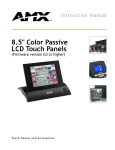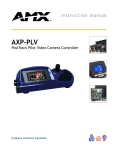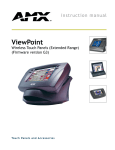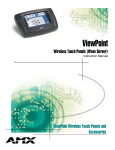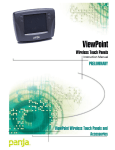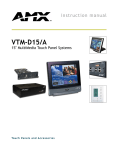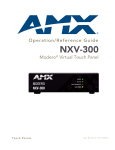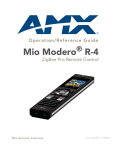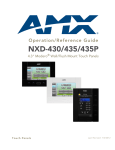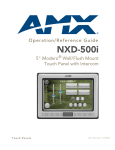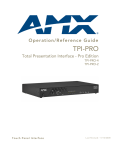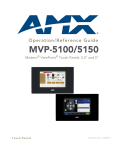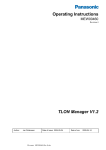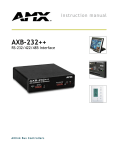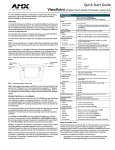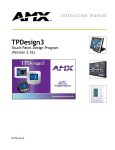Download 6" Color Video Wall Panel - AV-iQ
Transcript
instruction manual
6" Color Video
Wall Panel
(Firmware version G3 or higher)
Tou c h Pa n els an d A cc e ss o r ie s
AMX Limited Warranty and Disclaimer
AMX Corporation warrants its products to be free of defects in material and workmanship under normal use for
three (3) years from the date of purchase from AMX Corporation, with the following exceptions:
•
Electroluminescent and LCD Control Panels are warranted for three (3) years, except for the display and touch
overlay components that are warranted for a period of one (1) year.
•
Disk drive mechanisms, pan/tilt heads, power supplies, MX Series products, and KC Series products are
warranted for a period of one (1) year.
•
Unless otherwise specified, OEM and custom products are warranted for a period of one (1) year.
•
Software is warranted for a period of ninety (90) days.
•
Batteries and incandescent lamps are not covered under the warranty.
This warranty extends only to products purchased directly from AMX Corporation or an Authorized AMX Dealer.
AMX Corporation is not liable for any damages caused by its products or for the failure of its products to perform.
This includes any lost profits, lost savings, incidental damages, or consequential damages. AMX Corporation is not
liable for any claim made by a third party or by an AMX Dealer for a third party.
This limitation of liability applies whether damages are sought, or a claim is made, under this warranty or as a tort
claim (including negligence and strict product liability), a contract claim, or any other claim. This limitation of
liability cannot be waived or amended by any person. This limitation of liability will be effective even if AMX
Corporation or an authorized representative of AMX Corporation has been advised of the possibility of any such
damages. This limitation of liability, however, will not apply to claims for personal injury.
Some states do not allow a limitation of how long an implied warranty last. Some states do not allow the limitation or
exclusion of incidental or consequential damages for consumer products. In such states, the limitation or exclusion of
the Limited Warranty may not apply. This Limited Warranty gives the owner specific legal rights. The owner may
also have other rights that vary from state to state. The owner is advised to consult applicable state laws for full
determination of rights.
EXCEPT AS EXPRESSLY SET FORTH IN THIS WARRANTY, AMX CORPORATION MAKES NO
OTHER WARRANTIES, EXPRESSED OR IMPLIED, INCLUDING ANY IMPLIED WARRANTIES OF
MERCHANTABILITY OR FITNESS FOR A PARTICULAR PURPOSE. AMX CORPORATION
EXPRESSLY DISCLAIMS ALL WARRANTIES NOT STATED IN THIS LIMITED WARRANTY. ANY
IMPLIED WARRANTIES THAT MAY BE IMPOSED BY LAW ARE LIMITED TO THE TERMS OF THIS
LIMITED WARRANTY.
Table of Contents
Table of Contents
Product Information .................................................................................................1
Specifications .................................................................................................................... 1
Cleaning the Touch Overlay.............................................................................................. 2
Installation .................................................................................................................3
Mounting Decor-style Panels ............................................................................................ 3
Mounting the Decor-style panel into a pre-wall conduit box (BB-CV6) .................................... 3
Mounting the Decor-style panel on a flat or solid surface ........................................................ 4
Mounting the Decor-style panel on plasterboard (dry wall)...................................................... 7
Wiring the Touch Panel ..................................................................................................... 8
Preparing captive wires............................................................................................................ 9
Wiring guidelines...................................................................................................................... 9
Using AXlink for data and power............................................................................................ 10
Using AXlink for data with a +12 VDC power supply ............................................................. 10
Using a BNC video cable to provide video input .................................................................... 10
Using the (DB-9) RS-232 connector for mouse control or data ............................................. 11
Designing Touch Panel Pages ..............................................................................13
Buttons ............................................................................................................................ 13
Activating Edit Mode........................................................................................................ 14
Setting the Device Base .................................................................................................. 16
Setting the Device Used.................................................................................................. 16
Adding a Page................................................................................................................. 16
Setting the page color ............................................................................................................ 16
Adding a Button............................................................................................................... 16
Resizing a button ................................................................................................................... 16
Defining On-Screen and External Button Properties....................................................... 17
Setting the channel code........................................................................................................ 17
Setting the variable text code................................................................................................. 18
Setting the page flip ............................................................................................................... 18
Setting the button colors for channel-off conditions ............................................................... 18
Adding text, icons, and bitmaps to a button ........................................................................... 18
Using TPDesign3 to Download Bitmaps, Icons, and Fonts............................................. 19
Creating a Bargraph and Joystick ................................................................................... 19
Adding a bargraph or joystick button\..................................................................................... 20
Setting Bargraph and Joystick Properties ....................................................................... 20
Setting the level code............................................................................................................. 20
6” Color Video Wall Panel
i
Table of Contents
Programming .......................................................................................................... 21
Serial Commands............................................................................................................ 21
System Send_Commands .............................................................................................. 23
Video Send_Commands ................................................................................................. 29
Programming Numbers ................................................................................................... 31
Shorthand Send_Commands.......................................................................................... 32
Color Send_Commands.................................................................................................. 36
Variable Text Send_Commands ..................................................................................... 38
Shorthand Variable Text Commands .............................................................................. 40
Button String Commands ................................................................................................ 43
Upgrading the Firmware ........................................................................................ 45
Configuration................................................................................................................... 45
Downloading the Firmware ............................................................................................. 45
Replacing the Battery ............................................................................................ 47
AXD-CV6 Battery Replacement ...................................................................................... 47
ii
6” Color Video Wall Panel
Product Information
Product Information
The AMX™ Color Video Wall Panel (AXD-CV6) contains a 6" (14.40 cm visible area) 256-color
active-matrix liquid crystal display (LCD). The self-contained enclosure uses a microprocessor to
control a wide range of multimedia equipment. The TPDesign3 touch panel design program makes
it possible to create custom pages with buttons, icons, sliders, bargraphs, time displays, logos, and
drawings. The AXD-CV6 (CV6) is designed for wall mounting with a Decor-style bezel and the
use of an optional BB-CV6 conduit/wall box for pre-installed surfaces. The CV6 is designed to be
mounted to any level surface. FIG. 1 shows the 6" Color Video Wall Panel.
Front view
Rear view
FIG. 1 Decor-style Color Video Wall Panel views
Specifications
Specifications
Dimensions (HWD):
AXT-CV6
• Decor Faceplate: 5.37" x 6.79" x 0.30" (13.64 cm x 17.25 cm x 0.76 cm)
• BB-CV6 Conduit/Wallbox with connectors: 4.37" x 5.91" x 2.45" (11.09 cm x
15.01 cm x 6.22 cm)
• BB-CV6 Conduit/wallbox (without connections): 4.37" x 5.91" x 2.09" (11.09 cm x
15.01 cm x 5.31 cm)
• Without connections indicates the depth of the wallbox if the protruding
connectors were not considered in the dimensions.
Weight
7.74 lbs. (3.51 kg)
Power Consumption
610 mA @ 12 VDC
Screen Resolution (HV)
320 x 240 pixels
Video Monitor
6-inch (15.24 cm) color active-matrix LCD screen (visible area: 5.16" - 14.40 cm)
Video In
BNC male cable (NTSC/PAL/SECAM)
Memory
512 KB of SRAM and 2 MB of Flash for a total memory of 2.5 MB
(only 2 MB is available for buttons, icons, bitmaps, and fonts).
6" Color Video Wall Panel
1
Product Information
Specifications (Cont.)
Rear Connectors:
AXlink
4-pin bus connector for connection to the AMX Central Controller.
PWR
+12 VDC power supply; power is supplied through the bus or an external PSN power
supply.
RS-232
DB-9 male connector for data transmission or Microsoft® mouse control
Video
Character Support
BNC female connector (NTSC/PAL/SECAM)
Unicode® character support for far-eastern languages such as Chinese.
Characters for middle-eastern languages such as Arabic are not supported within
the Unicode fonts because they are bi-directional. Buttons with Unicode fonts can
only be created and edited using TPDesign3 and NetLinx Studio. Refer to the
respective manuals for additional information.
Compatibility
Axcess, NetLinx, and Landmark systems (AXlink is the most common control standard for this system).
Operating Environment
Indoor operation at temperatures between 0º C (32º F) to 50º C (122º F) and a
humidity range of 5% to 90% RH (non-condensing).
Installation Kit
• 4-pin AXlink data/power connector
• 2-pin PWR connector
• Drywall clip set (2-drywall clamps and 2- #8 (2" long) screws)
• 4-#4-40 machine screws and threaded inserts
Enclosure
• Metal sub-plate and bezel with black or white matte finish
• Detachable magnetic front panel bezel
Installation Cutout
Cutout Template for the AXD-CV6 is available as drawing number 62-5924-06 and
inserted in the product packaging. This file provides 1:1 cutout dimensions for the
CV6 conduit/wallbox. For replacement of the cutout, contact your AMX sales representative.
Optional Accessories
• PSN2.8 Power supply (can be used to power the CV6)
• PSN6.5 Power supply (recommended to power the CV6)
• Optional spacers and bezels for international sales
• BB-CV6 Conduit/wallbox (includes flanges for installation to studs during the
construction phase). Conduit/Wallbox should only be mounted to a beam
before a drywall is installed (pre-wall).
Cleaning the Touch Overlay
You should clean the touch screen overlay often. Always use clean cotton cloths, and a spray bottle
of cleaning solution consisting of 50% isopropyl alcohol and 50% water.
2
6" Color Video Wall Panel
Installation
Installation
Mounting Decor-style Panels
The following paragraphs describe mounting the Decor-style touch panel using the different types
of available methods and surfaces.
Mounting the Decor-style panel into a pre-wall conduit box (BB-CV6)
The CV6 Conduit/wallbox is an optional metallic housing that is installed onto a beam in a
pre-wall setting. The CV6 is housed in a plastic backbox (BB-CV6) that ships with the unit. To
install Decor-style touch panels into a conduit/wallbox pre-mounted within a solid surface:
1. Remove the magnetically attached faceplate (A in FIG. 2) from the main AXD unit
(B in FIG. 2) by gripping the faceplate and pulling with gentle force.
2. Remove any necessary wiring cutouts from the pre-installed (optional) conduit box
(C in FIG. 2) (BB-CV6) where the AXlink cable is threaded through for connection to the
touch panel (FIG. 2). The snaps located along the side of the conduit/wallbox can be snapped
off or used to mount the unit to a hard surface (like a wooden support beam).
Removable
tabs used to
mount the box
to a stud beam
C - Optional BB-CV6
conduit/wallbox
Install the (2) #4-40
screws into the places
indicated
Cable
knockouts
Installed flush
against a solid
surface
Do not use these
tabs to mount
conduit /wallbox
A - Decor
faceplate
B - Main AXD unit consists of
the touch panel and backbox housing
FIG. 2 Decor-style panel installation configuration for pre-existing conduit/wall box
3. Thread the incoming AXlink wiring through the knockout.
4. Disconnect the AXlink connector from the Central Controller and thread the terminal end of
the 4-pin AXlink cable through the circular cable knockouts provided on the wallbox.
5. Attach the data and power wiring to the touch panel.
6. Test the connection by reconnecting the AXlink connector to the Central Controller.
6" Color Video Wall Panel
3
Installation
7. Verify that the panel is receiving power and functioning properly. This should be done to
prevent repetition of the installation.
8. Disconnect the AXlink connector from the Central Controller until the installation of the panel
is complete.
9. Connect the data and power wiring to the rear of the touch panel.
10. Fasten the BB-CV6 to the stud through the tabs shown in FIG. 3. The wallbox can be secured
to the stud by using either nails or screws. This installation must be done prior to any wall
installation.
Stud
Tabs may be removed if not used for the installation
BB-CV6 Conduit Wallbox
Sheet
rock
TYPICAL DRYWALL INSTALLATION
FIG. 3 Screw location for attachment of the BB-CV6 in a typical drywall installation
11. Slide the main unit (B in FIG. 2) into the conduit/wallbox (C in FIG. 2) until it slides in
completely and flush against the wallbox.
12. Use the securing machine #4-40 screws (four provided) to attach the main AXD unit to the
wall box. The screws fit in the indicated holes on the main unit (FIG. 2).
13. Place the magnetic faceplate (A in FIG. 2) on the main touch panel unit. Make sure the
faceplate is flush against the housing and it is secure.
14. Reconnect the AXlink wiring to the Central Controller. The touch panel beeps when power is
applied.
Mounting the Decor-style panel on a flat or solid surface
To install Decor-style touch panels:
1. Remove the magnetically attached Decor faceplate (A in FIG. 4) from the main AXD unit
(B in FIG. 4) by gripping the faceplate and pulling with gentle force.
2. Cut out the surface using the dimensions shown in FIG. 5. Be sure not to cut out notches for the
expansion clips (only used when mounting the panel in plasterboard). FIG. 6 shows a sample
of the CV6 (62-5924-06) cutout template used for an accurate visual reference of the cutout
dimensions.
3. Thread the incoming AXlink wiring through the cutout on the flat surface.
4. Disconnect the AXlink connector from the Central Controller and thread the terminal end of
the 4-pin AXlink cable through the circular cable knockouts provided on the wallbox.
5. Attach the data and power wiring to the touch panel.
4
6" Color Video Wall Panel
Installation
Solid surface
(can include a
wall, podium, or
other level
surface)
Install the #4-40
machine screws
into the holes
shown below.
These 4 screws
are removed
to access or
replace the
battery.
Screw length
depends on the
installation surface.
A - Decor
faceplate
B - Main AXD unit consists of
the touch panel and housing
FIG. 4 Decor-style panel installation configuration for flat /solid surfaces
6.79
(BEZEL)
6.21
.12
5.97
.28 REF
.76
ZERO RADIUS REQUIRED
IN THESE 4 CORNERS.
2.900
THESE 4 HOLES ARE ONLY REQUIRED
WHEN MOUNTING UNIT TO A SOLID
SURFACE (PODIUM, DESK, ETC.).
SECURE UNIT WITH #4 SCREWS.
SUGGEST INSTALLATION OF #4-40
THREADED INSERTS AT THESE 4
LOCATIONS.
4.43
5.37
(BEZEL)
CUTOUT
FRONT BEZEL
FRONT BEZEL
#4-40 machine screw inserts (#4 screws)
used for mounting to a flat surface (provided by
installer)
FIG. 5 Decor-style panel cutout dimensions for flat surface mounting
6. Test the connection by reconnecting the AXlink connector to the Central Controller. Verify that
the panel is receiving power and functioning properly to prevent repetition of the installation.
7. Disconnect the AXlink connector from the Central Controller until installation is complete.
8. Connect the data and power wiring to the rear of the touch panel.
6" Color Video Wall Panel
5
Installation
U
P
CUT-OUT TEMPLATE
AXD-CV6
(NOT FOR USE WITH BB-CV6 CONDUIT BOX)
U
P
DRYWALL CLIPS (2)
2" LONG SCREWS (2)
NOTE ORIENTATION REAR CONNECTORS
TOWARDS TOP
THESE 4 HOLES ARE REQUIRED
ONLY WHEN MOUNTING UNIT TO A
SOLID SURFACE (PODIUM, DESK, ETC.).
SECURE UNIT WITH #4 SCREWS.
SUGGEST INSTALLATION OF #4-40
THREADED INSERTS AT THESE 4
LOCATIONS.
FRONT BEZEL
If something happens
to the template, contact
your sales representative
for another copy.
THESE 2 NOTCHES ARE REQUIRED
ONLY IF UNIT IS INSTALLED USING
DRYWALL EXPANSIONS CLIPS
(2 PROVIDED)
FIG. 6 Sample router cutout dimension template for the CV6
9. Insert the main unit into the flat surface mounting until firmly positioned and flush with the
surface battery.
10. Fasten the main AXD unit to the surface using the four surface-screws (#4 screws) supplied
with the enclosure (FIG. 7).
Surface mount screws
are inserted through the
outer holes along the housing.
Four drilled holes correspond
to the four (#4) screws used to
secure the housing to the flat surface.
FIG. 7 Screw locations for flat surface mounting of the main AXD unit
11. Place the magnetic Decor faceplate (A in FIG. 7) onto the main AXD unit (B in FIG. 7) by
gripping the faceplate and placing it on with gentle force.
12. Reconnect the AXlink wiring to the Central Controller. The touch panel beeps when power is
applied.
6
6" Color Video Wall Panel
Installation
Mounting the Decor-style panel on plasterboard (dry wall)
1. Remove the magnetically attached Decor faceplate (A in FIG. 8) from the main AXD unit
(B in FIG. 8) by gripping the faceplate and pulling with gentle force.
Flat surface
(can include a
wall, podium, or
other level
surface)
Install the 2 drywall
clips and screws
(included) into the
holes
2 notches are
required if the unit
is installed in
drywall using the (2)
provided clips
A - Decor
faceplate
B - Main AXD unit consists of
the touch panel and housing
FIG. 8 Decor-style panel installation configuration for drywall surfaces
The drywall clip set must be re-ordered from AMX if the drywall clip is bent
accidentally during an installation or removed during a re-installation.
2. Cut out the install surface using the dimensions shown in FIG. 9. Be sure to cut out the two
notches along the side of the CV6 to accommodate the two provided drywall expansion clips.
2.45
[62.2 MM]
Front view
2.09
[53.1 MM]
Side view
.30 [7.6 MM]
MAX
6.79
(BEZEL)
6.21
.12
5.97
.28 REF
.76
1.71
ZERO RADIUS
TYP. ALL CORNERS.
5.37
(BEZEL)
2.900
1.00
.140 DIA HOLES
(CUTOUT)
5.37
[136.5 MM]
4.37
[110.9 MM]
.25 TYP
WALL
CUTOUT
4.43
FIG. 9 Decor-style panel installation configuration for plasterboard
6" Color Video Wall Panel
7
Installation
3. Thread the incoming AXlink wiring through the cutout in the wall.
4. Disconnect the AXlink connector from the Central Controller and thread the terminal end of
the 4-pin AXlink cable through the circular cutout provided on the wallbox.
5. Attach the data and power wiring to the touch panel.
6. Test the connection by reconnecting the AXlink connector to the Central Controller. Verify that
the panel is receiving power and functioning properly to prevent repetition of the installation.
7. Disconnect the AXlink connector from the Central Controller until installation is complete.
8. Connect the data and power wiring to the rear of the touch panel.
9. Insert the main unit into the wall cutout until firmly positioned and flush with the wall.
10. Fasten the main AXD unit to the surface using the two (2) drywall clip sets (consisting of
screws and clips) supplied with the enclosure (FIG. 10).
Dry wall screws
are inserted through the
center holes on the housing.
Dry wall clips and screws
are inserted through the
notches cut out in the wall.
FIG. 10 Screw and clip locations for plasterboard (dry wall) mounting of main AXD unit
11. Place the magnet faceplate (A in FIG. 8) onto the main AXD unit (B in FIG. 8) by gripping the
faceplate and placing it on with gentle force.
12. Reconnect the AXlink wiring to the Central Controller. The touch panel beeps when power is
applied.
Wiring the Touch Panel
The touch panel uses a 4-pin AXlink connector for power and data (FIG. 11). If the distance
between the panel and Central Controller exceeds power consumption limits, you must connect an
optional 12 VDC power supply to the 2-pin PWR connector. If the panel is connected to an AXlink
cable and receiving power from a 2-pin PWR connector, power is not sent through the AXlink cable
to any connected device.
Some installations may require a 90° right-angle BNC adapter to accomodate a
sharp bend in the video cable. Be careful not to crimp the video cable and possibly
damage the BNC connector by bending the video cable too far.
8
6" Color Video Wall Panel
Installation
2-pin PWR
connector
4-pin AXlink
connector
BNC (female) video connector
DB-9 RS-232 connector
AXD-CV6 (Rear view)
FIG. 11 Rear views of the AXD-CV6 wall panel
Preparing captive wires
You will need a wire stripper and flat-blade screwdriver to prepare and connect the captive wires.
1. Strip 0.25 inch of wire insulation off all wires.
2. Insert each wire into the appropriate opening on the connector according to the wiring
diagrams and connector types described in this section.
3. Turn the flat-blade screws clockwise to secure the wire in the connector. Do not over-torque
the screws; doing so can bend the seating pin and damage the connector.
Do not connect power to the touch panel until wiring is complete. If you are using a
12 VDC power supply, apply power to the touch panel only after installation is
complete.
Wiring guidelines
The touch panel requires 12 VDC power to operate properly. The touch panel can use either a
PS(N)2.8 (if the power is being supplied only to the touch panel) or a PS(N)6.5 power supply (if the
power is being routed through the touch panel to power another device). The Central Controller
supplies power via the AXlink cable or external 12 VDC power supply. The maximum wiring
distance between the Central Controller and touch panel is determined by power consumption,
supplied voltage, and the wire gauge used for the cable. The table below lists wire sizes and the
maximum lengths allowable between the touch panel and Central Controller. The maximum wiring
lengths for using AXlink power are based on a minimum of 13.5 volts available at the Central
Controller’s power supply. Refer to the Specifications section on page 1 for more information.
Wiring Guidelines
Wire Size Maximum Wiring Length
18 AWG
99.47 feet (30.32 m)
20 AWG
62.93 feet (19.18 m)
22 AWG
39.23 feet (11.96 m)
24 AWG
24.73 feet (7.54 m)
If you install the touch panel farther away from the Central Controller than recommended in the
Wiring Guidelines table, connect an external 12 VDC power supply to the panel, as shown in
FIG. 12 and FIG. 13.
6" Color Video Wall Panel
9
Installation
Using AXlink for data and power
Connect the Central Controller’s AXlink connector to the AXlink connector on the touch panel for
data and 12 VDC power, as shown in FIG. 12.
Touch
Panel
PWR (+)
AXP
AXM
GND (-)
PWR (+)
AXP
AXM
GND (-)
Central Controller
FIG. 12 AXlink wiring diagram
Using AXlink for data with a +12 VDC power supply
To use the AXlink 4-pin connector for data communication (with the Central Controller) and power
transfer (from a power supply), the incoming PWR and GND cable from the power supply must be
connected to the AXlink cable connector going to the touch panel. FIG. 13 shows the external
power supply diagram.
12 VDC power supply
PWR (+)
GND (-)
Touch
Panel
PWR (+)
AXP
AXM
GND (-)
PWR (+)
AXP
AXM
GND (-)
Central Controller
FIG. 13 AXlink and external 12 VDC power supply wiring diagram
1. Unscrew the PWR and GND wires on the terminal end of the power supply’s 2-pin cable.
2. Pair the GND wires from the power supply and Central Controller AXlink connectors together;
insert them into the clamp position for GND on the touch panel AXlink connector.
3. Tighten the clamp and secure the two GND wires.
Never connect both power wires from the power supply and Central Controller to the
PWR terminal on the touch panel AXlink connector. Only the power supply PWR wire
should be connected to the touch panel AXlink connector. If both sources are used to
provide power to the touch panel, an electrical hazard is created and the threat of
both equipment damage and personal injury is likely.
4. Place the PWR wire from the power supply into the open clamp position for PWR on the touch
panel AXlink connector.
Using a BNC video cable to provide video input
Connect the control system’s video connector to the rear of the AXD-CV6 using a BNC cable to
provide a video feed, as seen in FIG. 14.
Some installations may require a 90° right-angle BNC adapter to accomodate a
sharp bend in the video cable. Be careful not to crimp the video cable and possibly
damage the BNC connector by bending the video cable too far.
10
6" Color Video Wall Panel
Installation
GND (-)
Video wire
BNC (female) connector
BNC (male) connectors
Rear panel
view AXD-CV6
Female video
source connector
FIG. 14 BNC cable connection from the AXD-CV6 to the video source
Using the (DB-9) RS-232 connector for mouse control or data
The dual-function (DB-9) RS-232 connector supports most standard serial mouse control devices
and RS-232 communication protocols for PC data transmission.
The following table lists the (DB-9) RS-232 connector pinouts and FIG. 15 shows the (DB-9)
RS-232 connector and power supply wiring diagram.
(DB-9) RS-232 Connector Pinouts
Pin
Signal
Function
1
N/A
Not used
2
RXD
Receive data
3
TXD
Transmit data
4
DTR
Data terminal ready (not used)
5
GND
Signal ground
6
DSR
Data set ready (not used)
7
RTS
Request to send (not used)
8
CTS
Clear to send (not used)
9
N/A
Not used
9
8
9
8
5
4
3
2
1
7
6
Female
7
6
Male
Power connector
+ (PWR)
- (GND)
12 VDC power supply
Optional 7 to 8-pin
connector
5 (GND)
5 (GND)
3 (TXD)
2 (RXD)
3 (TXD)
2 (RXD)
Touch panel
DB-9 connector
Mouse or PC, DB-9 connector
Male
Female
FIG. 15 DB-9 RS-232 connector and power supply wiring diagram
Use connector pins 2, 3, and 5 for data and ground. For some applications, you may need to strap
pins 7 (request to send) and 8 (clear to send) together, depending on the PC.
6" Color Video Wall Panel
11
Installation
12
6" Color Video Wall Panel
Designing Touch Panel Pages
Designing Touch Panel Pages
There are two ways to approach creating touch panel pages:
!
TPDesign3 - Refer to the TPDesign3 Touch Panel Program (Version 3. 16) instruction
manual for more information.
!
On-board editor
This document describes basic use of the on-board editor to create pages and buttons. Refer to the
G3 Firmware Design and Reference instruction manual for more detailed firmware information.
Buttons
Standard button types include rectangles and other geometric shapes you can create with the touch
panel editor. Buttons are set with attributes, meaning there is a response from the Central Controller
when you touch the button.
General buttons are part of the default touch panel program and cannot be changed. General buttons
create or revise pages and specify panel communication parameters. Button examples include
selection buttons, information buttons, adjustment buttons, and operation bars. The general button
categories are described in the table below.
General Button Categories
Selection buttons
Selection buttons appear on touch panel pages and set communication parameters.
Information buttons
Information buttons contain serial numbers and firmware version
information. The properties of these buttons cannot be changed.
These buttons have a dark fill and light text.
Adjustment buttons
You can use the UP and DN buttons to set adjustment buttons. The
adjustment button example sets the baud rate for the connection
from the touch panel to the computer.
Keypad buttons
The keypad button opens a keypad so you can enter a password or
value assignment. All keypad buttons are interactive except for the
entry display.
Decision buttons
Decision buttons appear when an operation has two options and
requires verification before an action is performed.
6" Color Video Wall Panel
13
Designing Touch Panel Pages
General Button Categories (Cont.)
Status buttons
Status buttons always have a dark fill with light letters and have no
functionality except to display information.
Operation bars
Operation bars appear in the place of the Editor bar, after selecting a
button or page edit operation. The operation bar indicates which edit
function is currently active. When an edit operation is selected, it
remains active until you press EXIT.
Touch to Continue buttons
"Touch to Continue" buttons appear when an operation requires user
acknowledgement.
Joystick buttons
Joysticks are vertical and horizontal direction controllers for use with
pan and tilt camera controllers.
Bargraph buttons
Bargraph buttons display a dynamic bargraph (vertical or horizontal).
An example is the battery level indicator button.
Activating Edit Mode
Before designing touch panel pages and buttons, you must activate Edit mode. Once activated, use
the EDIT button to enter Edit mode. This mode has options to add and configure touch panels and
buttons. When powering up the touch panel, the first page is the Main page (see FIG. 16). Note that
the Edit button is not available initially. If you have a pre-programmed panel, you may not see the
Main page.
FIG. 16 Main Page
To activate edit mode:
1. Press SETUP in the Main page to open the Setup page (FIG. 17).
2. Press PROTECTED SETUP to open the keypad.
3. Enter 1988 (default password) in the keypad and press ENTER to open Protected Setup page. If
you press ENTER after typing an incorrect password, you are immediately returned to the
previous page.
14
6" Color Video Wall Panel
Designing Touch Panel Pages
FIG. 17 Setup page
4. Press EDITOR to enable Edit mode. The EDITOR button is highlighted in the Protected Setup
page when enabled, as shown in FIG. 18.
FIG. 18 Protected Setup page with the active EDITOR button
5. Press EXIT to close the Protected Setup page and return to the Setup page (now the Edit mode).
6. Press EXIT again to return to the Main page. The EDIT button appears at the top of the page
indicating Edit mode is active.
7. Press EDIT to open the Edit bar. The BUTTON and PAGE options, in the Edit bar, (FIG. 19) are
used to design and modify button and page settings.
Edit bar
FIG. 19 Main page with Edit bar
6" Color Video Wall Panel
15
Designing Touch Panel Pages
Setting the Device Base
Press the DEVICE BASE option, in the Protected Setup page (FIG. 18), to assign a base (starting)
device address to the touch panel.
1. Enter the base address for the touch panel. The base address range is from 1 - 255. Standard
device addresses begin at 128.
2. Press ENTER to save.
Setting the Device Used
Use the DEVICE USED option in the Protected Setup page (FIG. 18) to assign a value for the
number of devices being controlled by the touch panel.
1. Press DEVICE USED to open the keypad and enter the panel’s device number from 1 - 4. Each
device number supports up to 255 programmable channel codes. The multiple device settings
allow you to create up to four unique touch panel buttons and/or pages. This value is used to
determine the current device being used by the panel.
2. Enter the number of devices being used by the touch panel.
3. Press ENTER to save the value.
Adding a Page
1. Press PAGE on the Edit bar to open the PAGE menu.
2. Press ADD to open the keyboard and enter a name for the new page. Page names can be up to
20 characters.
3. Press EXIT CHANGE to save, close the keyboard, and go to the new page.
Setting the page color
1. Press EDIT to open the Edit bar on the newly created page.
2. Press PAGE on the Edit bar to open the PAGE menu.
3. Press PAGE COLOR to open the color palette.
4. Select a color from the palette; the page automatically changes to the new color.
Adding a Button
To add a button to the current page:
1. Press BUTTON on the Edit bar to open the BUTTON menu.
2. Press ADD to open the ADD BUTTON operation bar. On the LCD screen, touch and drag to
create a button. The first touch point is the upper-left corner of the button.
Resizing a button
1. Press BUTTON on the Edit bar to open the BUTTON menu.
2. Press RESIZE. Then, touch any edge of the button and drag. Removing your finger from the
panel saves the button dimensions.
16
6" Color Video Wall Panel
Designing Touch Panel Pages
Defining On-Screen and External Button Properties
External pushbuttons are configured with features similar to on-screen buttons. Their functionality
can be set just as any other button on the touch panel.
Use the PROPERTIES option of the BUTTON menu in the Edit bar to set button borders, page flips,
button colors for channel on/off conditions, channel/variable text codes, and string/macro
assignments.
External button properties include only the button type, page flips, channel codes, and string/macro
assignments. Although the Border and Color sections of this page appear, they are of no use to
external pushbuttons since they do not appear on-screen.
To set button properties:
1. Press BUTTON on the Edit bar to open the BUTTON menu options.
2. Press PROPERTIES to open the PROPERTIES operation bar.
3. Press the new button to open the Button Properties page. This page lists the properties for the
active button.
4. Press BUTTON TYPE; this opens the BUTTON TYPE menu.
5. Choose a button type for the selected button to open the associated Button Properties page.
Each button type has its own Button Properties page with settings specific to the button.
6. Press BORDER to open the BUTTON BORDER pages.
7. Select a border to set for the button and return to the Button Properties page. The BORDER
button changes to show the selected border type.
Setting the channel code
The channel button sets the device and button channel codes. Channel codes and variable text codes
work the same for all button types, including joysticks and bargraphs.
1. In the Button Properties page, press DEV to open the keypad and set the touch panel’s device
number.
2. Enter 1, 2, 3, or 4 in the keypad. The programming software uses device codes 1 - 4 to identify
the touch panel. Refer to the G3 Firmware Design and Reference instruction manual for more
information.
If DEVICE USED is set to 4 and Base Device Number is 128, the Controller recognizes
bus devices 128 - 131.
The panel will not allow you to enter a device number greater than the DEVICE USED
without first displaying a decision box asking if you accept the new selection or not.
3. Press ENTER to save the device number, close the keypad, and return to the Button Properties
page.
4. Press CHAN to open the keypad and enter a channel value of 1 - 255. The source code uses the
channel code number to identify the button and its programmed operations. The channel code
for non-active buttons is 0.
5. Press ENTER to save the channel number, close the keypad, and return to the Button Properties
page.
6" Color Video Wall Panel
17
Designing Touch Panel Pages
Setting the variable text code
The variable text buttons set the device and button channel codes for the buttons.
1. Press DEV to open the keypad and set the device number.
2. Enter 1, 2, 3, or 4 in the keypad. The source code uses device codes 1 - 4 to identify the touch
panel.
3. Press ENTER to save, close the keypad, and return to the Button Properties page.
4. Press CHAN to open a keypad and set the channel number.
5. Enter a channel value of 1 - 255 in the keypad. The source code uses the channel code number
to identify the button and its operations.
6. Press ENTER to save the channel number, close the keypad, and return to the Button Properties
page.
Setting the page flip
1. Press the PAGE FLIP TYPE button (FIG. 20) in the Button Properties page to open the PAGE FLIP
TYPE menu.
Page FLIP type
button
Flip to Page button
FIG. 20 Page FLIP Type button
2. Select a Page Flip type. If you select FLIP STANDARD in the PAGE FLIP TYPE menu, the FLIP TO
PAGE button appears.
3. Press the FLIP TO PAGE button (FIG. 20) to open a list of all the saved touch panel pages. If the
desired page is not present in the menu, check to verify the page has been saved.
4. Select the target page for the page flip.
Setting the button colors for channel-off conditions
1. Press any button to open the Button Properties page.
2. Press BORDER under CHANNEL OFF in the Button Properties page. The color palette appears.
Select a color to set as the border.
3. Press the FILL button in the Button Properties page to open the palette. Select a color to set as
the fill.
4. Press the TEXT button to open the palette. Select a color to use for the text.
5. Press EXIT SAVE CHANGE in the Button Properties page to save the new button properties and
return to the current page.
Adding text, icons, and bitmaps to a button
1. Press BUTTON on the Edit bar to open the BUTTON menu.
2. Press TEXT/IMAGE to add text to the button. The TEXT/IMAGE operation bar appears.
3. Press any button to open the Text/Image page.
18
6" Color Video Wall Panel
Designing Touch Panel Pages
4. Go through each option and set as desired:
!
TEXT OFF and TEXT ON sets the text for the button's Off and On state.
!
ICON OFF and ICON ON sets the icon for the button's Off and On state.
!
BITMAP OFF and BITMAP ON sets the bitmap for the button's Off and On state.
!
MAKE ON SAME AS OFF sets the On and Off properties the same.
You cannot create or edit buttons with Unicode fonts on the panel. Any use of the
TEXT/IMAGE button to alter or create Unicode font supported buttons must be done
in the TPDesign3 Touch Panel Design Program.
5. Press EXIT SAVE CHANGE to close the Text/Image page and return to the Main page.
Using TPDesign3 to Download Bitmaps, Icons, and Fonts
TPDesign3 allows you to download bitmaps, icons, and fonts into your touch panel from an
existing touch panel program. Refer to the TPDesign3 Touch Panel Program instruction manual for
more information. Use the Download to Panel button to download a project file.
To download bitmaps, icons and/or fonts from an existing TPDesign3 project file:
1. Launch the TPDesign3 software program and open a project file that contains the desired
bitmaps, icons, and fonts.
2. Select File from the menu bar to open the File menu.
3. In the File menu, click on Download to Panel, this opens the Download to Panel dialog box.
4. Click on the Comm Settings tab to set the communications port, baud rate, and other settings.
5. Then, click the Actions tab to set the communication mode and select which elements of the
project file you want to download to the touch panel.
6. In the What To Send area, select one or more of the available options (All Bitmaps, All Icons,
All Fonts).
7. Select the mode of communication with the touch panel (RS-232 and AXlink). Confirm that
the correct panel is selected by verifying the ID values with the Base Address assigned to the
touch panel in the Protected Setup page.
8. After clicking Connect, the Available Panels list appears in the Available Panels field. Click
Begin to start downloading the project file into the panel.
9. After completing the download, the bitmaps, icons and fonts that were downloaded are now
accessible via the BITMAPS, ICONS and FONTS menus.
Creating a Bargraph and Joystick
Bargraphs are level monitors and adjustable level controls. These levels can be configured to
monitor and adjust audio outputs and lighting levels.
Joysticks are vertical and horizontal direction controllers you can use for camera for pan and tilt
control. Before starting, make sure to connect the touch panel to your Controller; otherwise, the
joystick will not work properly.
6" Color Video Wall Panel
19
Designing Touch Panel Pages
Adding a bargraph or joystick button\
Create a new button using the Add operation bar in the BUTTON menu.
1. Press BUTTON in the Edit bar to open the BUTTON menu.
2. Press PROPERTIES in the BUTTON menu to open the PROPERTIES operation bar.
3. Press any button to open the Button Properties page.
4. Press BUTTON TYPE to open the BUTTON TYPE menus. Choose a button type to open its
Button Properties page.
Setting Bargraph and Joystick Properties
Use the Button Properties page to set channel, level, and button colors. Refer to the Setting the
variable text code section on page 18 and the Setting the channel code section on page 17 for
further information. Refer to the Setting the button colors for channel-off conditions section on
page 18 for more information on colors for channel-off conditions.
Setting the level code
Level buttons set the device and number codes for the touch panel.
Joysticks use two level numbers. The first is for the X-axis and the second for the Yaxis. You only need to specify the first level.
1. Press DEV to open a keypad and set the device number.
2. Enter 1, 2, 3, or 4 in the keypad. The programming software uses device codes
1 - 4 to identify the touch panel.
3. Press ENTER to save the level device number, close the keypad, and return to the Button
Properties page.
4. Press NUM to open a keypad and set the level number assigned to the device.
5. Enter a number 1 – 8. Each device can have from 1 – 8 levels except joysticks, where the range
is 1 – 7.
6. Press ENTER to save, close the keypad, and return to the Button Properties page.
20
6" Color Video Wall Panel
Programming
Programming
You can program the touch panel, using the commands in this section, to perform a wide variety of
operations using Axcess Send_Commands and variable text commands. Use the commands
described in this section to program the touch panel.
Serial Commands
Serial Commands are used in the AxcessX Terminal Emulator mode. These commands are case
insensitive.
Serial Commands
?PAR
Returns panel
parameters to the
PC terminal.
Panel parameters include: firmware version, device number, mouse type, output resolution, number of devices, cursor enable, brightness (always=0), and contrast (always=0).
Syntax:
"?PAR"
Example:
?PAR
Requests the information.
$SC
Sends a serial
port
send_command
within a panel, as
if sent from
Axcess.
Syntax:
"$SC <device offset>,"’<send_command>,<variable
text #>,<data>’""
Variables:
device offset = Device number
variable text # = The variable text number value on the touch panel.
Example:
$SC 1,"’@TXT’,2,’TEXT’"
The string is sends the command to put text on a button with a variable text value of 2. It is
crucial that all the correct ’ and " be used with no spaces after the commas.
CALIBRATE
Starts touch panel
calibration.
Syntax:
"CALIBRATE"
Example:
CALIBRATE
Starts the calibration sequence mode on the touch panel.
CHECK CAL
Syntax:
Enters the calibra"CHECK CAL"
tion test mode.
Example:
CHECK CAL
Begins the calibration check mode on the touch panel.
6" Color Video Wall Panel
21
Programming
Serial Commands (Cont.)
ECHO ON
Syntax:
Turns On character echo.
Example:
"ECHO ON"
ECHO ON
The character echo is sent back to the computer.
ECHO OFF
Turns Off character echo.
Syntax:
"ECHO OFF"
Example:
ECHO OFF
The character echo is not sent back to the computer.
GET CAL
Gets the calibration variables.
Syntax:
"GET CAL"
Example:
GET CAL
Gets the calibration variables on the touch panel.
HELLO
Verifies that serial
communication is
working properly.
Syntax:
"HELLO"
Example:
HELLO
If the communication is active and working, the response is "How are you doing?".
MOUSE
Syntax:
Turns on serial
mouse or other
touch devices.
Variables:
MOUSE <mouse type>
mouse type =
00: Mouse cursor Off
01: Microsoft® serial mouse/cursor On
Example:
MOUSE 01
Turns on Microsoft® compatible serial mouse. Refer to the @MOU section on page 34 for
the chart describing the BIT information and definitions.
RESET
Cycles power on
the touch panel.
Syntax:
"RESET"
Example:
RESET
Cycles the power on the touch panel. Once the firmware is downloaded, send this command to recycle power to the panel. This command prevents the user from having to physically re-cycling power on the unit.
SET CAL
Sets the calibration variables.
Syntax:
“SET CAL <X Multiplier> <X Offset> <Y Multiplier> <Y
Offset>"
Example:
SET CAL 2F 3A 2B 62
Sets the calibration values on the touch panel.
22
6" Color Video Wall Panel
Programming
Serial Commands (Cont.)
SETUP
Syntax:
Puts the touch
panel on the
Setup Page.
Example:
"SETUP"
SETUP
Flips the touch panel to the Setup page.
VER
Restores the current version.
Syntax:
"VER"
Example:
VER
Returns the current version of the main firmware.
WORKING?
Syntax:
Verifies the com"WORKING?"
munication
Example:
between the touch
WORKING?
panel and the Terminal Emulator.
Response:
$SC 1,"’CPAGE72-Main Page’"
Responding touch panel turns its Main page the color white. This command verifies serial
communication. The CV6 panel must have a page named Main Page for this command to
work properly.
ZAP!
Clears all memory.
Syntax:
"ZAP!"
Example:
ZAP!
Clears all memory and erases all buttons, pages, drawings, and symbols.
Only use the ZAP! command to erase the saved data in the touch panel; data cannot be
recovered after it is erased.
System Send_Commands
System Send_Commands are stored in the Controller and direct the touch panel to perform various
operations.
System Send_Commands
$SP
Translates the ¦ and translates it as a carriage return to the next line.
Syntax:
Sends data out
the serial port with
"’$SP "<data>"’"
trailing CR and LF.
Example:
SEND_COMMAND TP,"’$SP "CALIBRATE"’"
Sends the Calibrate command to another panel through the Serial Port. It is crucial that all
the correct ’ and " be used with no spaces after the commas.
ABEEP
Syntax:
Outputs one panel
"’ABEEP’"
beep even if the
Example:
beep value is set
SEND_COMMAND TP,"’ABEEP’"
to 0 in the Setup
page.
Beeps the panel.
6" Color Video Wall Panel
23
Programming
System Send_Commands (Cont.)
ADBEEP
Syntax:
Outputs a double
"’ADBEEP’"
beep even if the
Example:
double beep value
SEND_COMMAND TP,"’ADBEEP’"
is set to 0 in the
Setup page.
Double beeps the panel.
AKEYB
The keyboard string is set to null during power-up and stored until power-down.
Opens the touch
panel keyboard
and initializes the
text string entry.
Syntax:
"’AKEYB-<text string>’"
Variable:
text string = 0 - 59 characters
Example:
SEND_COMMAND TP,"’AKEYB-TOUCH HERE’"
Opens the touch panel keyboard with TOUCH HERE in the display.
AKEYP
The keyboard string is set to null during power-up and stored until power-down.
Opens the touch
panel keypad and
initializes the
number string
entry.
Syntax:
"’AKEYP-<number string>’"
Variable:
number string = 0 - 9999
Example:
SEND_COMMAND TP,"’AKEYP-1988’"
Opens the touch panel keypad with 1988 in the display.
AKEYR
Closes/opens the
touch panel keyboard/pad.
Syntax:
"’AKEYR’"
Example:
SEND_COMMAND TP,"’AKEYR’"
Closes the keyboard/keypad opened using the ’AKEYB’, ’AKEYP’, or ’PKEYP’
commands.
BAUD
The baud rate can also be set in the Protected Setup page’s BAUD level indicator.
Sets the program
port baud rate.
Syntax:
"’BAUD <baud rate>’"
Variable:
baud rate = 38400, 19200, 9600, 4800, 2400, 1200, 600, and 300
Example:
SEND_COMMAND TP,"’BAUD 38400’"
Sets the Baud rate to 38400.
BEEP
This beep command sounds one tone for a time length of 50 milliseconds.
Gives an output of Syntax:
one beep.
"’BEEP’"
Example:
SEND_COMMAND TP,"’BEEP’"
Activates one beep tone. Beeps the panel if the Beep button is not set to 0.
The BEEP command will disable the beep after a QBEEP command.
24
6" Color Video Wall Panel
Programming
System Send_Commands (Cont.)
BRIT
Syntax:
Adjusts brightness
"’BRIT-<level>’"
of display.
Variable:
level = 1 - 8 (1 = minimum; 8 = maximum)
Example:
SEND_COMMAND TP,"’BRIT-8’"
Sets to highest brightness level.
CALIBRATE
Syntax:
Starts the touch
panel calibration
sequence.
Example:
"’CALIBRATE’"
SEND_COMMAND TP,"’CALIBRATE’"
Starts the calibration operation on the touch panel.
CLOCK
Sets the time and
date.
Syntax:
"’CLOCK <mm-dd-yy> <hh:mm:ss>’"
Variables:
mm = 01 - 12, dd = 01 - 31, yy = 00 - 99
hh = 00 - 23, mm = 00 - 59, ss = 00 - 59
Example:
SEND_COMMAND TP,"’CLOCK 02-08-98 19:16:00’"
Sets the touch panel’s date to February 8, 1998, and time to 7:16 p.m.
CURSOR
Syntax:
Turns the cursor
"’CURSOR <OFF/ON>’"
display On or Off if
Variables:
the touch device
Off = 0 and On = 1
has a cursor.
Example:
SEND_COMMAND TP,"’CURSOR 0’"
Turns the cursor display Off.
DBEEP
Gives a double
beep output.
This command only works if the Double Beep value in the Protected Setup page is set to
On.
Syntax:
"’DBEEP’"
Example:
SEND_COMMAND TP,"’DBEEP’"
Double beeps the panel.
ILEV
Syntax:
Inverts the joystick
"’ILEV <joystick axis to invert>’"
axis.
Variables:
joystick axis to invert =
0 : Normal G3 joystick (origin: top left)
1 : Invert horizontal axis (origin: top right)
2 : Invert vertical axis (origin: bottom left)
3 : Invert both axes (origin: bottom right)
Example:
SEND_COMMAND TP,"’ILEV 3’"
Inverts the joystick axis to move the origin to another corner.
6" Color Video Wall Panel
25
Programming
System Send_Commands (Cont.)
MOUSE
Syntax:
Turns on serial
mouse or other
touch devices.
Variables:
"’MOUSE <mouse condition>’"
mouse condition =
00: Mouse cursor Off
01: Microsoft® serial mouse/cursor On
Example:
SEND_COMMAND TP,"’MOUSE 01’"
Turns on Microsoft® compatible serial mouse. Refer to the @MOU section on page 34 for
the chart describing the BIT information and definitions.
PAGE
Flips to a page
with a specified
page name.
Syntax:
"’PAGE-<page name>’"
Variable:
page name = 1 - 50 ASCII characters
Example:
SEND_COMMAND TP,"’PAGE-MAIN PAGE’"
Flips the touch panel to the page named MAIN PAGE.
PKEYP
Displays asterisks (*) for keypad
entries.
Syntax:
"’PKEYP-<number string>’"
Variable:
number string = 0 - 9999
Example:
SEND_COMMAND TP,"’PKEYP-1988’"
Displays the touch panel keypad with **** instead of 1988.
PPOF
Closes a specific
popup page.
Syntax:
"’PPOF-<page name>’"
Variable:
page name = 1 - 50 ASCII characters
Example:
SEND_COMMAND TP,"’PPOF-Popup Page 1’"
Closes Popup Page 1.
PPON
Syntax:
Opens a specific
popup page.
Variable:
"’PPON-<page name>’"
page name = 1 - 50 ASCII characters
Example:
SEND_COMMAND TP,"’PPON-Popup Page 1’"
Opens Popup Page 1.
QBEEP
Stops all beeps.
Syntax:
"’QBEEP’"
Example:
SEND_COMMAND TP,"’QBEEP’"
Stops all beeps, including "’ABEEP’", "’ADBEEP’", and AXlink beeps.
26
6" Color Video Wall Panel
Programming
System Send_Commands (Cont.)
RESET
Syntax:
Cycles power on
the touch panel.
Example:
"RESET"
RESET
Cycles the power on the touch panel. Once the firmware is downloaded, send this command to recycle power to the panel. This command prevents the user from having to physically re-cycling power on the unit.
SETUP
Goes to the Setup
page.
Syntax:
"’SETUP’"
Example:
SEND_COMMAND TP,"’SETUP’"
Flips the touch panel to the Setup page.
SLEEP
Forces the touch
panel to screen
saver mode.
Syntax:
"’SLEEP’"
Example:
SEND_COMMAND TP,"’SLEEP’"
Activates the screen saver mode.
TPAGEOFF
Deactivates page
tracking.
Syntax:
"’TPAGEOFF’"
Example:
SEND_COMMAND TP,"’TPAGEOFF’"
Deactivates the page tracking option.
TPAGEON
See page 28 for a more detailed explanation.
Activates page
tracking.
WAKE
Deactivates
screen-saver
mode and resets
the sleep timer.
Syntax:
"’WAKE’"
Example:
SEND_COMMAND TP,"’WAKE’"
Deactivates the touch panel screen-saver mode and resets the sleep timer.
XMRT
Sets the new network communication retry value for
the panel and
SoftROM.
Syntax:
"’XMRT <number>’"
Variable:
number = 1 - 15 ASCII characters
Example:
SEND_COMMAND TP,"’XMRT 9’"
Sets the XMODEM wait for character retries to 9.
XMTO
Sets the new network communication delay for the
panel and SoftROM.
Syntax:
"’XMTO <number>’"
Variable:
number = 4 - 30 ASCII characters
Example:
SEND_COMMAND TP,"’XMTO 5’"
Sets the new XMODEM character delay time to 5 seconds.
6" Color Video Wall Panel
27
Programming
System Send_Commands (Cont.)
TPAGEON
Syntax:
Activates page
tracking.
Example:
"’TPAGEON’"
SEND_COMMAND TP,’TPAGEON’
DEFINE_DEVICE
TP1 = 128 (*AMX Touch Panel*)
TP2 = 129 (*AMX Touch Panel*)
DEFINE_VARIABLE
TP1_BUFFER[100] (*Buffer for TP1*)
TP2_BUFFER[100] (*Buffer for TP2*)
TRASH[50] (*For Parsing Above*)
DEFINE_START
CREATE_BUFFER TP1,TP1_BUFFER
CREATE_BUFFER TP2,TP2_BUFFER
SEND_COMMAND TP1,’TPAGEON’
SEND_COMMAND TP2,’TPAGEON’
DEFINE_PROGRAM
(***** PAGE TRACKING ROUTINE *******************)
IF(LENGTH_STRING(TP1_BUFFER))
{
IF(FIND_STRING(TP1_BUFFER,’PAGE-’,1)
{
TRASH=REMOVE_STRING(TP1_BUFFER,’PAGE-’,1)
SEND_COMMAND TP2,"’PAGE-’,TP1_BUFFER"
CLEAR_BUFFER TP1_BUFFER
}
IF((FIND_STRING(TP1_BUFFER,’PPON-’,1)))
OR(FIND_STRING(TP1_BUFFER, (’PPOF-’,1)))
{
SEND_COMMAND TP2,TP1_BUFFER
CLEAR_BUFFER TP1_BUFFER
}
}
IF(LENGTH_STRING(TP2_BUFFER))
{
IF(FIND_STRING(TP2_BUFFER,’PAGE-’,1))
{
TRASH=REMOVE_STRING(TP2_BUFFER,’PAGE-’,1)
SEND_COMMAND TP1,"’PAGE-’,TP2_BUFFER"
CLEAR_BUFFER TP2_BUFFER
}
IF((FIND_STRING(TP1_BUFFER,’PPON-’,1))
OR(FIND_STRING(TP1_BUFFER’,(PPOF-’,1)))
{
SEND_COMMAND TP1,TP2_BUFFER
CLEAR_BUFFER TP2_BUFFER
}
}
(***********************************
In this program, the command string is sent to the Controller in the ’PAGE-(page name)’ or
’PPON/PPOF-(page name)’ format. The string can be captured in the buffer for one panel
and sent to the other panel.
If panels are combined using the DEFINE_COMBINE statement, the routine needs to be
written only once, and the command is sent back to the same panel.
*********************************************************)
(************END OF PAGE TRACKING ROUTINE****************************)
28
6" Color Video Wall Panel
Programming
System Send_Commands (Cont.)
ZAP!
Clears all memory; erases buttons, pages,
drawings, and
symbols.
Syntax:
"’ZAP!’"
Example:
SEND_COMMAND TP,"’ZAP!’"
Clears all memory and erases all buttons, pages, drawings, and symbols.
Only use the ZAP! command to erase the saved data in the touch panel; data cannot be
recovered after it is erased.
Video Send_Commands
Video Send_Commands direct the touch panel to perform various video specific operations.
Video Send_Commands
@VBR
Sets the video signal brightness.
Syntax:
"’@VBR <ASCII setting for Brightness>’"
Variables:
ASCII brightness setting = 0 (min) - 255 (max)
Example:
SEND_COMMAND TP,"’@VBR 128’"
Sets the video brightness to 128.
@VBW
Sets the video to
black/white or
color.
Syntax:
"’@VBW <ASCII setting for Black/White input>’"
Variables:
Black/White input setting = 0: Color
1: Black and White
Example:
SEND_COMMAND TP,"’@VBW 1’"
Sets the video output to black and white.
@VCT
Sets the video
contrast.
Syntax:
"’@VCT <ASCII setting for Contrast>’"
Variables:
ASCII contrast setting = 0 (min) - 255 (max)
Example:
SEND_COMMAND TP,"’@VCT 128’"
Sets the video contrast to 128.
6" Color Video Wall Panel
29
Programming
Video Send_Commands (Cont.)
@VDD
Sets the video
setting for autodetection or manual detection of
the video standard.
Syntax:
"’@VDD <ASCII settings for video detection>’"
Variables:
ASCII detection settings = 1: Auto-detect video input
2: Manual set NTSC
3: Manual set PAL
4: Manual set SECAM
Example:
SEND_COMMAND TP,"’@VDD 3’"
Detects only PAL.
@VFF
Video Fast Forward Mode Alogrithm.
The algorithm creates independent vertical sync 60 Hz/50 Hz (NTSC/PAL or SECAM) timing, ignoring the sync from the VCR. During fast forward on many VCRs, the vertical sync
timing increases by 8 Hz, thus, causing the video pictures to freeze on our digital hardware.
Syntax:
"’@VFF <ASCII video fast forward settings>’"
Variables:
ASCII video settings = 0: Normal
1: On
2: Off (required for Tanberg’s non-interlacing equipment)
Example:
SEND_COMMAND TP,"’@VFF 2"
Turns the algorithm Off.
@VHU
Sets video hue.
Syntax:
"’@VHU <ASCII setting for Hue>’"
Variables:
ASCII hue setting = 0 (min) - 255 (max)
Example:
SEND_COMMAND TP,"’@VHU 128’"
Sets video hue to 128.
@VSD
Resets video
default settings.
Resets the following video attributes to their default settings:
Brightness, Contrast, Saturation, Hue, Interlace
Syntax:
"’@VSD’"
Example:
SEND_COMMAND TP,"’@VSD’"
Resets the video defaults.
@VST
Syntax:
Sets the video
saturation.
Variables:
"’@VST <ASCII setting for Saturation>’"
ASCII saturation setting = 0 (min) - 255 (max)
Example:
SEND_COMMAND TP,"’@VST 128’"
Sets video saturation to 128.
30
6" Color Video Wall Panel
Programming
Programming Numbers
The following information provides the programming numbers for colors, fonts, and borders.
Colors can be used to set the colors on buttons, sliders, gauges, and pages. The lowest color number
represents the lightest color-specific display; the highest number represents the darkest display. For
example, 0 represents light red, and 5 is dark red.
Colors and Programming Numbers
Color
No.
Color
No.
Red
0-5
Purple
54 - 59
Orange
6 - 11
Magenta
60 - 65
Yellow
12 - 17
Pink
66 - 71
Lime
18 - 23
White
72 - 77
Green
24 - 29
Light Gray
78 - 83
Aqua
30 - 35
Dark Gray
84 - 86
Cyan
36 - 41
Black
87
Royal
42 - 47
Transparent
255
Blue
48 - 53
Font styles are used to program the text fonts on buttons, sliders, gauges, and pages. Programming
numbers are assigned consecutively when downloaded to the touch panel.
Font Styles and Programming Numbers
No.
Font styles
No.
Font styles
1
Extra small
5
Extra large
2
Small
6
Hollow medium
3
Medium
8
Hollow extra large
4
Large
32 - 255
Variable fonts
You must import variable text fonts into a TPDesign3 project file, and download the
project file containing the fonts to the touch panel. The variable fonts are
programming numbers assigned by the touch panel during the download process.
Border styles can be used to program borders on buttons, sliders, and gauges.
Border Styles and Programming Numbers
No.
Border styles
No.
Border styles
0
No border
11
Double shadow
1
No border special
20
3-dimensional rectangle 1
2
Single line
21
3-dimensional rectangle 2
3
Double line
22
3-dimensional round 1
4
Triple line
23
3-dimensional round 2
5
Single rounded
24
3-dimensional neon 1
6
Double rounded
25
3-dimensional neon 2
7
Single raised
26
3-dimensional neon blue
8
Double raised
27
3-dimensional neon green
9
Triple raised
40
Single diamond
10
Double-line two single
41
Double diamond
6" Color Video Wall Panel
31
Programming
Shorthand Send_Commands
The shorthand commands operate control equipment just like standard Send_Commands still used
in a wide variety of AMX products. However, shorthand commands are smaller byte-for-byte, and
are processed more efficiently.
The table below lists the shorthand Send_Commands you can use with the AXD-CV6 touch panel.
The shorthand command data is 1-byte, non-ASCII format except for pages, passwords, text, and
bitmap names.
Shorthand Send_Commands
@CBF
This works only if the specified background color is not the same as the current color.
Sets the OFF
feedback border
color to the specified color.
Syntax:
"’@CBF’,<variable text address>,<color_number>"
Variables:
variable text address = 1 - 255
color number = See the Colors and Programming Numbers table on page 31.
Example:
SEND_COMMAND TP,"’@CBF’,1,0"
Sets the OFF feedback border color to Red for the variable text button 1.
@CBN
This works only if the specified background color is not the same as the current color.
Sets the ON feed- Syntax:
back border color
"’@CBN’,<variable text address>,<color_number>"
to the specified
Variables:
color.
variable text address = 1 - 255
color number = See the Colors and Programming Numbers table on page 31.
Example:
SEND_COMMAND TP,"’@CBN’,2,78"
Sets the ON feedback border color to Gray for variable text button 2.
@CFF
This only works if the specified background color is not the same as the current color.
Sets the OFF
feedback fill color
to the specified
color.
Syntax:
"’@CFF’,<variable text address>,<color_number>"
Variables:
variable text address = 1 - 255
color number = See the Colors and Programming Numbers table on page 31.
Example:
SEND_COMMAND TP,"’@CFF’,1,72"
Sets the OFF feedback fill color to White for variable text button 1.
@CFN
This only works if the specified background color is not the same as the current color.
Sets the ON feed- Syntax:
back fill color to
"’@CFN’,<variable text address>,<color_number>"
the specified
Variables:
color.
variable text address = 1 - 255
color number = See the Colors and Programming Numbers table on page 31.
Example:
SEND_COMMAND TP,"’@CFN’,1,30"
Sets the ON feedback fill color to Aqua for variable text button 1.
32
6" Color Video Wall Panel
Programming
Shorthand Send_Commands (Cont.)
@CPG
This only works if the new background color is not the same as the current color.
Sets the specified
page’s background color to
the specified
color.
Syntax:
"’@CPG’,<color_number>,’<page name>’"
Variables:
color number = See the Colors and Programming Numbers table on page 31.
page name = 1 – 50 ASCII characters
Example:
SEND_COMMAND TP,"’@CPG’,87,’Main Page’"
Sets the page title to Main Page, and the color to Black.
@CPP
This only works if the specified background color is not the same as the current color.
Sets the specified
page’s background color to
the specified
color.
Syntax:
"’@CPP’,<color_number>,’<pop-up page name>’"
Variables:
color number = See the Colors and Programming Numbers table on page 31.
pop-up page name = 1 – 50 ASCII characters
Example:
SEND_COMMAND TP,"’@CPP’,54,’Audio Page’"
Sets the popup page title to Audio Page, and the color to Purple.
@CTF
This only works if the specified background color is not the same as the current color.
Sets the OFF
feedback text
color to the specified color.
Syntax:
"’@CTF’,<variable text address>,<color_number>"
Variables:
variable text address = 1 – 255
color number = See the Colors and Programming Numbers table on page 31.
Example:
SEND_COMMAND TP,"’@CTF’,1,48"
Sets the OFF feedback text color to Blue for variable text button 1.
@CTN
This only works if the specified background color is not the same as the current color.
Sets the ON feed- Syntax:
back text color to
"’@CTN’,<variable text address>,<color_number>"
the specified
Variables:
color.
variable text address = 1 – 255
color number = See the Colors and Programming Numbers table on page 31.
Example:
SEND_COMMAND TP,"’@CTN’,1,72"
Sets the ON feedback text color to White for variable text button 1.
@IDF
Syntax:
The touch panel
returns its
MS-DOS file
name in a string.
Example:
"’@IDF’"
SEND_COMMAND TP,"’@IDF’"
The touch panel returns its MS-DOS file name in a string.
6" Color Video Wall Panel
33
Programming
Shorthand Send_Commands (Cont.)
@IDP
Queries the touch
panel to return a
string with the
TPDesign3
project name.
@MOU
Sets the serial
touch interface
type.
Syntax:
"’@IDP’"
Example:
SEND_COMMAND TP,"’@IDP’"
The touch panel returns a string containing the TPDesign3 project name.
When changing the serial touch device, you must connect the hardware before setting the
device type.
Syntax:
"’@MOU <touch_type>’"
Variables:
touch type =
00: Mouse cursor Off
01: Microsoft® serial mouse/cursor On
8000: Touch Output to Serial Port (Elo IntelliTouch)
Example:
SEND_COMMAND TP,"’@MOU 01’"
Sets the touch interface to Microsoft serial mouse.
@PPA
If no page is specified, the active page is used.
Removes all
Syntax:
popup pages from
"’@PPA-<page name>’"
a specified page.
Variable:
page name = target touch panel page name
Example:
SEND_COMMAND TP,"’@PPA-Main Page’"
If there were several popup pages on ’Main Page’ that are active, sending the previous
command would remove them all from that page.
@PPF
Deactivates a
popup page on a
touch panel page.
If a page name is empty, the current page is used. If a pop-up page is part of a group, the
whole group is deactivated.
Syntax:
"’@PPF-<popup page name>;<page name>’"
Variables:
popup page name = target popup page name
page name = target touch panel page name
Example:
SEND_COMMAND TP,"’PPF-Laser Disc 2 Transport Control;
Laser Disc Control Page’"
Deactivates the Laser Disc 2 Transport Control popup page on the Laser Disc Control
Page. If a page name is empty, the current page is used. If the popup page is part of a
group, the whole group is deactivated.
@PPK
If a pop-up page is part of a group, the whole group is deactivated.
Deactivates a
popup page on all
touch panel
pages.
Syntax:
"’@PPK-<popup page name>’"
Variable:
popup page name = target popup page name
Example:
SEND_COMMAND TP,"’@PPK-Laser Disc 2 Transport Control’"
Deactivates the Laser Disc 2 Transport Control popup page on all touch panel pages.
34
6" Color Video Wall Panel
Programming
Shorthand Send_Commands (Cont.)
@PPN
If a page name is empty the current page is used.
Activates a popup
page on a touch
panel page.
Syntax:
"’@PPN-<popup page name>;<page name>’"
Variables:
popup page name = popup page name
page name = page name
Example:
SEND_COMMAND TP,"’@PPN-Laser Disc 2 Transport Control;
Laser Disc Control Page’"
Activates the Laser Disc 2 Transport Control popup page on the Laser Disc Control Page.
@PPX
The group that needs to be turned Off must contain the given popup page.
Removes all panel Syntax:
popup pages.
"’@PPX-<popup page>’"
Variable:
popup page = popup page name
Example:
SEND_COMMAND TP,"’@PPX’"
Closes all popup pages from all of the pages in the panel.
@PWD
Syntax:
Sets the password
"’@PWD-<page flip password>’"
for the Page Flip
Variable:
on the touch
page flip password = 0 - 9999
panel.
Example:
SEND_COMMAND TP,"’@PWD-1988’"
Sets the page flip password to 1988.
@RDW
Redraws the current screen.
Syntax:
"’@RDW’"
Example:
SEND_COMMAND TP,"’@RDW’"
Sends a message to the touch panel to redraw the screen.
@SSL
Changes the
Sleep string sent
to the Controller
when the touch
panel activates
sleep mode.
Syntax:
"’@SSL-<string>’"
Variable:
string = alphanumeric characters
Example:
SEND_COMMAND TP,"’@SSL-Touch Panel Deactivated’"
Sends Touch Panel Deactivated to the Controller.
@SST
Syntax:
Changes the Star"’@SST-<string>’"
tup string sent to
Variable:
the Central Constring = alphanumeric characters
troller when the
touch panel pow- Example:
ers up.
SEND_COMMAND TP,"’@SST-Touch Panel Power On’"
Sends touch panel Power On to the Central Controller when the touch panel powers up.
6" Color Video Wall Panel
35
Programming
Shorthand Send_Commands (Cont.)
@SWK
Changes the
Wakeup string
sent to the Controller when the
touch panel is
activated.
Syntax:
"’@SWK-<string>’"
Variable:
string = alphanumeric characters
Example:
SEND_COMMAND TP,"’@SWK-Touch Panel Activated’"
Sends Touch Panel Activated to the Central Controller.
Color Send_Commands
Use the color Send_Commands to set the colors for text, buttons, and pages. Use the same
command for setting gray scale values only change the color number value to reflect the gray scale
(72-86) value.
Color Send_Commands
CALL
You must use the variable text assignments to change button colors (see the Colors and
Sets the colors for Programming Numbers table on page 31).
a variable text but- Syntax:
ton.
"’CALL<variable text address>-<data>’"
Variables:
variable text address = 1 - 255
data = 6 color number series for:
FILL COLOR ON
FILL COLOR OFF
BORDER COLOR ON
BORDER COLOR OFF
TEXT COLOR ON
TEXT COLOR OFF
Example:
SEND_COMMAND TP,"’CALL1-1 3 0 0 72 74’"
Sets variable text button 1 to:
FILL COLOR ON = Red one shade from brightest
FILL COLOR OFF = Red three shades from brightest
BORDER COLOR ON = Red brightest
BORDER COLOR OFF = Red brightest
TEXT COLOR ON = White brightest
TEXT COLOR OFF = White two shades from brightest
36
6" Color Video Wall Panel
Programming
Color Send_Commands (Cont.)
CBOFF
Syntax:
Sets the OFF
feedback border
color to the specified color.
Variables:
"’CBOFF<variable text address>-<color_number>’"
variable text address = 1 - 255
color number = See the Colors and Programming Numbers table on page 31.
Example:
SEND_COMMAND TP,"’CBOFF1-72’"
Sets the OFF feedback border color to White for the variable text button 1.
CBON
Syntax:
Sets the ON feed"’CBON<variable text address>-<color _number>’"
back border color
Variables:
to the specified
variable text address = 1 - 255
color.
color number = See the Colors and Programming Numbers table on page 31.
Example:
SEND_COMMAND TP,"’CBON1-87’"
Sets the ON feedback border color to Black for variable text button 1.
CFOFF
Syntax:
Sets the OFF
feedback fill color
to the specified
color.
Variables:
"’CFOFF<variable text address>-<color_number>’"
variable text address = 1 - 255
color number = See the Colors and Programming Numbers table on page 31.
Example:
SEND_COMMAND TP,"’CFOFF1-72’"
Sets the OFF feedback fill color to White for variable text button 1.
CFON
Syntax:
Sets the ON feed"’CFON<variable text address>-<color_number>’"
back fill color to
Variables:
the specified
variable text address = 1 - 255
color.
color number = See the Colors and Programming Numbers table on page 31.
Example:
SEND_COMMAND TP,"’CFON1-87’"
Sets the ON feedback fill color to Black for variable text button 1.
CPAGE
Syntax:
Sets the back"’CPAGE<color_number>-<page name>’"
ground page color
Variables:
to the specified
color number = See the Colors and Programming Numbers table on page 31.
color.
page name = 1 - 50 ASCII characters (page names are case sensitive.)
Example:
SEND_COMMAND TP,"’CPAGE255-MAIN PAGE’"
Sets the background color on the MAIN PAGE to Transparent.
6" Color Video Wall Panel
37
Programming
Color Send_Commands (Cont.)
CTOFF
Syntax:
Sets the OFF
feedback text
color to the specified color.
Variables:
"’CTOFF<variable text address>-<color_number>’"
variable text address = 1 - 255
color number = See the Colors and Programming Numbers table on page 31.
Example:
SEND_COMMAND TP,"’CTOFF1-87’"
Sets the OFF feedback text color to Black for variable text button 1.
CTON
Syntax:
Sets the ON feed"’CTON<variable text address>-<color_number>’"
back text color to
Variables:
the specified
variable text address = 1 - 255
color.
color number = See the Colors and Programming Numbers table on page 31.
Example:
SEND_COMMAND TP,"’CTON1-72’"
Sets the ON feedback text color to White for variable text button 1.
Variable Text Send_Commands
Use variable text Send_Commands to set the borders, fonts, and text.
Variable Text Send_Commands
!B
Sets a specific
button to On or
Off.
Syntax:
"’!B’,<variable text address>,<ON/OFF>"
Variables:
variable text address = 1 - 255
ON = 0
OFF = 1
Example:
SEND_COMMAND TP,"’!B’,128,1"
Sets button 128 Off.
BTOF
Syntax:
Sets a specific
button's active
state to Off.
Variable:
"’BTOF<variable text address>’"
variable text address = 1 - 255
Example:
SEND_COMMAND TP,"’BTOF255’"
Sets the state for button 255 to Off.
BTON
Sets a specific
button's active
state to On.
Syntax:
"’BTON<variable text address>’"
Variable:
variable text address = 1 - 255
Example:
SEND_COMMAND TP,"’BTON128’"
Sets the state for button 128 to On.
38
6" Color Video Wall Panel
Programming
Variable Text Send_Commands (Cont.)
!C
Sets the border,
font, and text in
one command.
Syntax:
"’!C’,<variable text address>,<border style>,<font
size>,’<new button text>’"
Variables:
variable text address = 1 - 255
border style = See the Border Styles and Programming Numbers table on page 31.
font size = See the Font Styles and Programming Numbers table on page 31.
new button text = Enter button text to appear on the button.
Example:
SEND_COMMAND TP,"’!C’,1,6,6,’VCR PLAY’"
Sets the title on variable text button one to VCR PLAY using a hollow medium font, and
changes the border attribute to double rounded.
!F
Shorthand version of ’FONT’
command.
Syntax:
"’!F’,<variable text address>,’<font size>’"
Variables:
variable text address = 1 - 255
font size = See the Font Styles and Programming Numbers table on page 31.
Example:
SEND_COMMAND TP,"’!F’,’1,’6’"
Changes the font on the variable text button one to hollow medium.
FONT
Changes the font
size (or style) of
the text in a specific button.
Syntax:
"’FONT<variable text address>-<font size>’"
Variables:
Variable text address = the number of the variable text button (1-255)
Font size/style = the size or style of the font (1-255). See the Font Styles and
Programming Numbers table on page 31 for more information.
Example:
SEND_COMMAND TP,"’FONT1-6’"
Changes the font on the variable text button one to hollow medium. Variable fonts start at
a value of 32.
!I
Shorthand version of 'ICON'
command.
Syntax:
"’!I’,<variable text address>,’<border style>’"
Variables:
variable text address = 1 - 255
border style = 0 - 41. See the Border Styles and Programming Numbers table on
page 31.
Example:
SEND_COMMAND TP,"’!I’,1,’6’"
Changes the border style on the variable text button one to double rounded.
ICON
Syntax:
Changes the bor"’ICON<variable text address>-<border style>’"
der style of a spe- Variables:
cific button.
variable text address = 1 - 255
border style = See the Border Styles and Programming Numbers table on page 31.
Example:
SEND_COMMAND TP,"’ICON25-6’"
Changes the border style on the variable text button 25 to double-rounded.
6" Color Video Wall Panel
39
Programming
Variable Text Send_Commands (Cont.)
!T
Syntax:
Shorthand version of 'TEXT'
command.
Variables:
"’!T’,<variable text address>,’<new button text>’"
variable text address = 1 - 255
new button text = 1 - 60 characters
Example:
SEND_COMMAND TP,"’!T’,1,’VCR PLAY’"
Changes the title on variable text button one to VCR PLAY.
TEXT
Use the | character to display text on multiple lines.
Enters text on a
button.
Syntax:
"’TEXT<variable text address>-<new button text>’"
Variables:
variable text address = 1 - 255
new button text = Enter button text to appear on button.
Example:
SEND_COMMAND TP,"’TEXT2-VCR|PLAY’"
Sets the VCR and PLAY text on variable button 2. The | character places VCR on a text
line above PLAY on the button.
Shorthand Variable Text Commands
The table below lists the shorthand variable text commands you can use with the touch panel. The
shorthand command data is one-byte, non-ASCII format except for pages, passwords, text, and
bitmap names.
Shorthand Variable Text Commands
@BMP
Adds a bitmap file
to a button.
Bitmap files are imported into TPDesign3; the numbers are assigned by the touch panel
during the download process.
Syntax:
"’@BMP’,<variable text address>,’<bitmap>’"
Variables:
variable text address = 1 - 255
bitmap = Bitmap chosen from a file location
Example:
SEND_COMMAND TP,"’@BMP’,85,’Bitmap1’"
Adds the Bitmap1 file to button 85.
@BOR
Sets the border
style on a button.
Syntax:
"’@BOR’,<variable text address>,<border style>"
Variables:
variable text address = 1 - 255
border style = See the Border Styles and Programming Numbers table on page 31.
Example:
SEND_COMMAND TP,"’@BOR’,65,11"
Sets the border style to double shadow on button 65.
40
6" Color Video Wall Panel
Programming
Shorthand Variable Text Commands (Cont.)
@BMF
This command allows you to program up to 12 attributes on one command line.
Syntax:
Sets multiple
attributes to a but"’@BMF’,<variable text address>,’<attribute data>’"
ton, slider, or
Variables:
gauge.
variable text address = 1 - 255
attribute data:
’%R,<left>, <top>, <right>, <bottom>’ = Sets the rectangle position.
’%B’,<border styles> = See the Border Styles and Programming Numbers table on
page 31.
’%F’,<font styles> = See the Font Styles and Programming Numbers table on page 31.
’%T’,<button text > = ASCII characters (empty is clear)
’%P’,<bitmap> = Bitmap filename (empty is clear)
’%I’,<icon> = 1 - 255 (icon numbers are assigned in TPDesign3 project file)
’%J’,<text alignment> = 1 - 9 as shown the following alignment chart:
1
2
3
4
5
6
7
8
9
For %C1-%C6, see the Colors and Programming Numbers table on page 31.
’%C1’,<on-state fill color>
’%C2',<off-state fill color>
’%C3’,<on-state border color>
’%C4’,<off-state border color>
’%C5’,<on-state text color>
’%C6’,<off-state text color>
Example:
SEND_COMMAND TP,"’@BMF’,255,’%T POWER |ON’
’%B’,’4’,’%C1’,’72’"
Sets the text on button 255 to POWER ON (appears on two lines), adds a triple-line border, and sets the On-state color to White.
@ENA
Enables/disables
buttons based on
the variable text
channel.
Syntax:
"’@ENA’,<variable text address>,<disable button on/off>"
Variables:
variable text address = 1 – 255
disable button on/off=
1 : button disabled
0 : button enabled
Example:
SEND_COMMAND TP,"’@ENA’,128,1"
Disables the button with variable text channel 128. This button will stop responding to
pushes completely, until it is sent an Enable command. Nothing short of a touch panel
SoftROM firmware reload will re-enable the button. Reloading the touch panel file, reloading the Axcess program, or resetting power on the panel or master will not re-enable the
button. It must be sent an Enable command once it has been disabled.
6" Color Video Wall Panel
41
Programming
Shorthand Variable Text Commands (Cont.)
@FON
Syntax:
Sets the text font
on a button.
Variables:
"’@FON’,<variable text address>,<font style>"
variable text address = 1 - 255
font style = See the Font Styles and Programming Numbers table on page 31.
Example:
SEND_COMMAND TP,"'@FON',56,32"
Sets the text on button 56 to variable font style 32.
@ICO
Assigns an icon to
a button.
Syntax:
"’@ICO’,<variable text address>,<icon file number>"
Variables:
variable text address = 1 - 255
icon file number = 1 - 255
Example:
SEND_COMMAND TP,"’@ICO’,16,12"
Adds icon 12 on button 16. Setting the icon value to 0 clears the appearance of the icon.
@JUS
Syntax:
Sets the text
alignment on a
button.
Variables:
"’@JUS’,<variable text address>,<text alignment>"
variable text address = 1 - 255
text alignment = 1 - 9 as shown in the following alignment chart:
1
2
3
4
5
6
7
8
9
Example:
SEND_COMMAND TP,"’@JUS’,9,5"
Centers the text on button 9.
@SHO
Sets a specific
button to on or off.
Syntax:
"’@SHO’,<variable text address>,<button on/off>"
Variables:
variable text address = 1 - 255
button on/off=
0 : button Off
1 : button On
Example:
SEND_COMMAND TP,"’@SHO’,128,0"
Sets button 128 off.
42
6" Color Video Wall Panel
Programming
Shorthand Variable Text Commands (Cont.)
@TXT
Use the | character to display text on multiple lines.
Adds text to a but- Syntax:
ton.
"’@TXT’,<variable text address>,’<text>’"
Variables:
variable text address = 1 - 255
text = Enter button text to appear on the button.
Example:
SEND_COMMAND TP,"’@TXT’,2,’VCR|PLAY’"
Sets the VCR and PLAY text on variable button 2. The | character places VCR on a text
line above PLAY on the button.
@UNI
Characters for Middle Eastern languages, such as Arabic, are not supported within the
Adds Unicode text Unicode fonts because they are bi-directional. Buttons with Unicode fonts can only be created and edited using TPDesign3 Touch Panel Design Program.
to a button.
Syntax:
"’@UNI’,<variable text address>,’<text>’"
Variables:
variable text address = 1 - 255
text = Enter button text to appear on button.
Example:
SEND_COMMAND TP,"’@UNI’,2,’Foreign Text’"
Sets the Foreign Text on variable button 2.
Button String Commands
The table below lists string commands you can assign to buttons by using the touch panel editor.
Select the PROPERTIES option in the Edit bar, press the target button, and enter the string
command with the Touch Panel keyboard.The string command is sent to the control system
when you press the button.
Button String Commands
$CU
Syntax:
Turns the cursor
display On and
Off.
Variable:
"$CU <cursor value>"
cursor value = 0 (Off) and 1 (On)
Example:
$CU 0
Turns the cursor Off.
$SC
Sends a serial
port
send_command
within a panel, as
if sent from
Axcess.
Syntax:
"$SC <device offset>,"’<send_command>,<variable
text #>,<data>’""
Variables:
device offset = Device number
variable text # = The variable text number value on the touch panel.
data = 0 - 59 characters
Example:
$SC 1,"’@TXT’,2,’TEXT’"
The string sends the command to put text on a button with a variable text value of 2.
Its crucial that all the correct ’ and " be placed with no spaces after commas.
6" Color Video Wall Panel
43
Programming
Button String Commands (Cont.)
$SL
Syntax:
Activates sleep
mode on the
touch panel.
Example:
"$SL"
$SL
Activates sleep mode on the touch panel.
$SP
Syntax:
Sends data out
"$SP"<data>""
through the serial
Variables:
port of the source
panel to a destina- data = Serial string command
tion panel.
Examples:
$SP "CALIBRATE"
Sends the Calibrate command to another panel through the Serial Port.
$SP "$SC 1,"’@TXT’,1,’TEST’""
Uses the $SP command to send a Send Command ($SC ***) to another panel through the
Serial Port. This is an on-panel button string that is entered using on-screen keyboard.
$ST
When the touch panel’s input time matches the sleep time, the panel goes to sleep.
Sets the idle time
to activate sleep
mode for a touch
panel in 1-minute
increments.
Syntax:
"$ST<sleep timeout>"
Variable:
sleep timeout = 1 (Off) - 120 (in minutes)
Example:
$ST 5
Sets the touch panel’s sleep time to 5 minutes.
WORKING?
Verifies the communication
between touch
panels through
the use of the onpanel editor.
Responding touch panels tell the sending touch panel to change its Main page to the color
white.
Syntax:
"WORKING?"
Example:
• CV6 panel serial port is connected to TPI program port.
• CV6 panel wants to verify communication between the TPI and itself.
• CV6 panel issues "WORKING?" to its serial port. It will be sent as $SP "WORKING?".
• TPI receives the command and responds to the CV6 panel by telling it to set the Main
page background to white. Thus communication is verified.
44
6" Color Video Wall Panel
Upgrading the Firmware
Upgrading the Firmware
To upgrade the firmware, your PC must be connected to the DB-9 program port, on the controller,
using a DB-9 programming cable. The panel must also be connected to the Controller via a miniAXlink connection.
If power is lost during the download process, the unit powers up with the same set of code prior to
the download.
There is a small window during which a loss of power can be catastrophic. If power is
lost between the erase of flash memory and the completion of copying the new boot
code from RAM to flash memory, the unit will not operate at all when power returns.
If you have not already installed the SoftROM program, do so by following the steps on the AMX
Control Disc.
Configuration
To configure the communication setting for the SoftROM program:
1. Press F1 to open the Configuration screen.
2. Using the up/down arrow keys, select the communications port you are using to interface with
the controller and press ENTER.
3. Using the right arrow key, move to the BAUD RATE column. Then, use the up/down arrow
keys to select the interface communications speed and press ENTER. Be sure the BAUD
RATE selections match the setting on the Controller.
4. Press F10 to save the communication settings and exit the Configure screen.
Downloading the Firmware
1. Press F5 to acquire the list of online programmable devices.
You can press F2 to select all ONLINE programmable devices and F3 to clear all devices.
2. Using the up/down arrow keys, select your firmware version listed in the Firmware column of
the screen, and press ENTER.
3. Using the Tab key, switch to the ONLINE MASTERS list and select the device to be
programmed.
4. Press ENTER for each device as it is selected.
5. Press F4 to program the selected device; a loading message appears.
6. Press F5 to refresh the screen. Verify that the selected device has the correct firmware version.
If any devices still appear with an old firmware version, repeat steps as necessary until it
appears with the correct version.
6" Color Video Wall Panel
45
Upgrading the Firmware
Firmware can be downloaded to multiple device numbers automatically. If multiple devices are
selected, the bottom half of the loading bar indicates the percentage complete for the selected
devices.
7. Press F10 to exit the SoftROM program.
46
6" Color Video Wall Panel
Replacing the Battery
Replacing the Battery
There is one lithium battery on the touch panel card, with a life of approximately 2.5 years. It
protects stored commands and pages against a power outage. The battery is not used when DC
power is supplied to the touch panel. Write down the replacement date on a label by adding 2.5
years to the date of installation; attach it to the panel for future reference.
FIG. 21 Lithium battery and socket
Static electricity can damage electronic circuitry. Before removing the touch panel
circuit card from the enclosure, discharge any accumulated static electricity from your
body and flat-blade tool by touching a grounded metal object.
Before replacing the lithium battery, make sure you have a current copy of the pages stored in the
touch panel. This will avoid any inadvertent loss of data or service outage. To replace the lithium
battery, you will need a Phillips screwdriver and a non-conducting flat-blade tool to slip under the
battery to pry it up and out of the socket.
AXD-CV6 Battery Replacement
To remove the lithium battery from the touch panel:
1. Discharge the static electricity from your body by touching a grounded object and remove the
magnetically attatched the faceplate.
2. Removing the main unit:
!
From the BB-CV6 conduit/wallbox by carefully unscrewing the four-#4 screws from the
threaded inserts located along the sides of the housing. Refer to FIG. 2 on page 3 for
more information.
!
From solid/flat surface by carefully unscrewing the four-#4 screws from the threaded
inserts located along the sides of the housing. Refer to FIG. 4 on page 5 for more
information.
!
From a plasterboard (drywall) surface by carefully unscrewing the two screws from the
drywall clips. Once these drywall clips are separated from their screws, the drywall clip
set must be re-order from AMX before the unit can be mounted to this type of surface
again. Refer to FIG. 8 on page 7 for more information.
3. Pull the touch panel forward until the whole unit slides out of the surface/wallbox.
4. Disconnect all the connectors to remove the touch panel from the conduit/wallbox or
equipment rack.
6" Color Video Wall Panel
47
Replacing the Battery
5. Place the touch panel facedown onto a soft cloth and begin unscrewing the four screws
securing the housing to the main unit. Refer to FIG. 4 on page 5 for more information.
6. Remove the touch overlay’s ribbon cable connectors from the circuit card.
7. Remove the upper circuit card and turn it over.
8. Carefully pry the battery out of its socket and insert the new battery.
9. Replace the circuit card and insert/tighten the circuit card spacers.
10. Connect the touch overlay’s ribbon cable connector to the circuit card.
11. Re-insert and tighten the housing screws to its four locations along the outside of the housing
box.
12. Return the touch panel to the backbox or equipment rack and connect the AXlink connector.
13. Insert the four mounting screws/two expansion clips, and tighten.
14. Put the magnetic faceplate back onto the main unit and verify that it is secure.
48
6" Color Video Wall Panel
Replacing the Battery
6" Color Video Wall Panel
49
brussels • dallas • los angeles • mexico city • philadelphia • shanghai • singapore • tampa • toronto* • york
3000 research drive, richardson, TX 75082 USA • 469.624.8000 • 800.222.0193 • fax 469.624.7153 • technical support 800.932.6993
036-004-2488 7/02 ©2002 AMX Corporation. All rights reserved. AMX, the AMX logo, the building icon, the home icon, and the light bulb icon are all trademarks of AMX Corporation.
AMX reserves the right to alter specifications without notice at any time. *In Canada doing business as Panja Inc.
AMX reserves the right to alter specifications without notice at any time.






















































